Research on the Blocking Mechanism of Stagnant Water and the Prediction of Scaling Trend in Fractured Reservoirs in Keshen Gas Field
Abstract
1. Introduction
2. On-Site Description
3. Experimental Methods
3.1. Experimental Samples
3.1.1. Standard Samples
3.1.2. On-Site Samples
3.2. Experimental Instruments
3.3. On-Site Rock Sample Analysis Method
3.4. Reservoir Blocking Mechanism and Scaling Prediction
3.4.1. High-Temperature and High-Pressure Stagnant Water—Petrophysical Simulation Experiments
3.4.2. Research Experiments on the Mechanism of Visual Scaling and Blockage
3.5. Geochemical Model (Reservoir-Scale Prediction Model)
- m—Name of the mth mineral;
- Xm—Molar fraction of m minerals,%;
- λm—the thermodynamic activity coefficient of m;
- Km—the corresponding equilibrium constant of m;
- cj—The molar concentration of the j-th water complex, mol·L−1;
- γj—Thermodynamic activity coefficient;
- Nc—The number of reactions;
- vmj—Stoichiometric coefficients of the j-th component in the m-th mineral.
- Ea—Reaction activation energy, kJ·(kmol·K)−1;
- k25 °C—Reaction rate constant at 25 °C, mol·(L·s)−1;
- R—Gas constant, J·(kg·K)−1;
- T—Absolute temperature, K.
- F—The flow rate of the fluid in the wellbore, t·hr−1;
- Pb—The pressure of the wellbore, bar;
- Pi—Initial reservoir pressure, bar;
- nm—Quantity of minerals;
- frm—Volume fraction of the mineral m in the rock;
- fru—The volume fraction of rocks in the rock that is not involved in the reaction.
- k—Permeability, μm2;
- ki—Initial permeability, μm2;
- Øi—Initial porosity
- Ar—Reaction surface area,m2;
- Af−m—Fracture − matrix interface area to volume ratio;
- Øf−m—Crack porosity of rocks, %.
4. Results and Discussion
4.1. On-Site Rock Sample Analysis
4.2. Study on Reservoir Scaling and Blocking Mechanism
4.3. Reservoir-Scaling Prediction
- U—The internal energy of the fluid;
- p—The pressure of the fluid;
- V—The volume of the fluid;
- H—Enthalpy of the fluid.
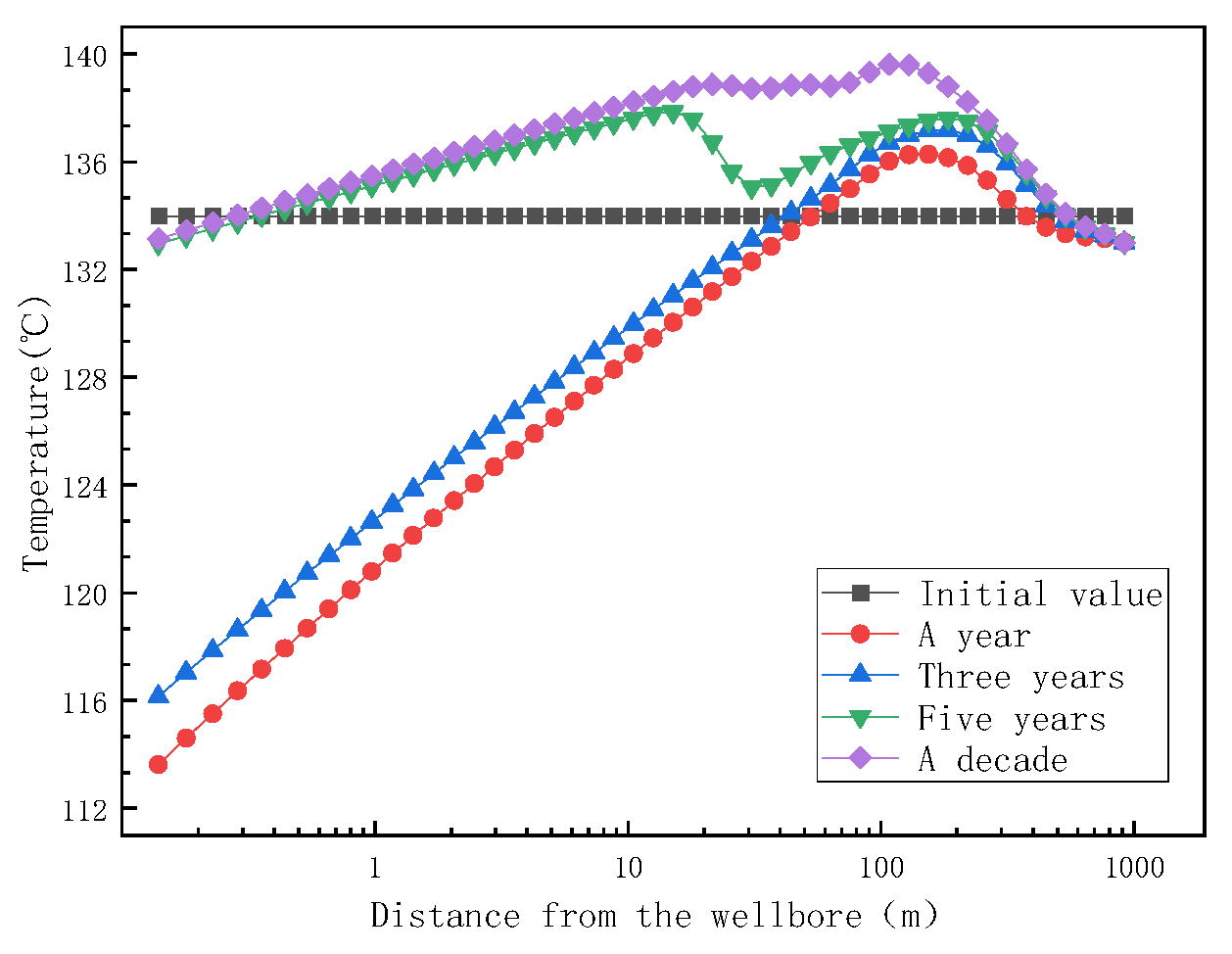
5. Conclusions
- (1)
- The physical simulation experiments of high temperature and high pressure show that, under the influence of carbon dioxide and formation water, the dissolution rate of minerals in the water–rock system is higher than the sedimentation rate, and the pore size of the rock increases. The microscopic visualization model shows that the small fractures are blocked first, and then, the large fractures are blocked in the reservoir. There are many small fractures in the large fractures, and the blockages mostly occur at the throat reduction. The blockage of the reservoir flow channel is caused by the migration of the precipitated crystals caused by the interaction between the stagnant water and the reservoir rock;
- (2)
- The prediction results show that the scaling is more serious when the fractures occur in the well inlet zone than when the fractures appear in the far well zone;
- (3)
- When the fracture location is the same, the deposition amount of large fractures is six times that of small fractures, and the scaling situation in large fractures is more serious.
Author Contributions
Funding
Data Availability Statement
Conflicts of Interest
Nomenclature
| m | Name of the mth mineral | nm | Quantity of minerals |
| Molar fraction of m minerals | Volume fraction of the mineral m in the rock | ||
| the thermodynamic activity coefficient of m | The volume fraction of rocks in the rock that is not involved in the reaction | ||
| the corresponding equilibrium constant of m | k | Permeability | |
| Initial permeability | |||
| Thermodynamic activity coefficient | Initial porosity | ||
| The number of reactions | Critical porosity | ||
| Stoichiometric coefficients of the j-th component in the m-th mineral | n | Power exponent | |
| Reaction activation energy | Reaction surface area | ||
| Reaction rate constant at 25 °C | Fracture–matrix interface area to volume ratio | ||
| R | Gas constant | Crack porosity of rocks | |
| T | Absolute temperature | U | The internal energy of the fluid |
| F | The flow rate of the fluid in the wellbore | p | The pressure of the fluid |
| The pressure of the wellbore | V | The volume of the fluid | |
| Initial reservoir pressure | H | Enthalpy of the fluid |
References
- Shen, Y.; Lü, X.; Guo, S.; Song, X.; Zhao, J. Effective evaluation of gas migration in deep and ultra-deep tight sandstone reservoirs of Keshen structural belt, Kuqa depression. J. Nat. Gas Sci. Eng. 2017, 46, 119–131. [Google Scholar] [CrossRef]
- Wang, J.; Wang, H.; Zhang, R.; Dong, L.; Wang, K.; Zhang, Z. Improvement of reservoir quality of ultra-deep tight sandstones by tectonism and fluid: A case study of Keshen gas field in Tarim Basin, western China. Petroleum 2023, 9, 124–134. [Google Scholar] [CrossRef]
- Wang, Z.; Xu, K.; Zhang, H.; Wang, H.; Yin, G.; Wang, Z.; Zhao, W. Fracture Effectiveness Evaluation of Ultra-Deep Tight Sandstone Reservoirs: A Case Study of the Keshen Gas Field, Tarim Basin, West China. Front. Earth Sci. 2022, 10, 883479. [Google Scholar] [CrossRef]
- Aljuboori, F.A.; Lee, J.H.; Elraies, K.A.; Stephen, K.D. The effectiveness of low salinity waterflooding in naturally fractured reservoirs. J. Pet. Sci. Eng. 2020, 191, 107167. [Google Scholar] [CrossRef]
- Bagheri, H.; Falahat, R. Fracture permeability estimation utilizing conventional well logs and flow zone indicator. Pet. Res. 2022, 7, 357–365. [Google Scholar] [CrossRef]
- Jafari, A.; Babadagli, T. Estimation of equivalent fracture network permeability using fractal and statistical network properties. J. Pet. Sci. Eng. 2012, 92–93, 110–123. [Google Scholar] [CrossRef]
- Miao, T.; Yu, B.; Duan, Y.; Fang, Q. A fractal analysis of permeability for fractured rocks. Int. J. Heat Mass Transf. 2015, 81, 75–80. [Google Scholar] [CrossRef]
- Wang, R.; Zhang, C.; Chen, D.; Yang, F.; Li, H.; Li, M. Microscopic Seepage Mechanism of Gas and Water in Ultra-Deep Fractured Sandstone Gas Reservoirs of Low Porosity: A Case Study of Keshen Gas Field in Kuqa Depression of Tarim Basin, China. Front. Earth Sci. 2022, 10, 893701. [Google Scholar] [CrossRef]
- Wang, J.; Zhou, F. Cause analysis and solutions of water blocking damage in cracked/non-cracked tight sandstone gas reservoirs. Pet. Sci. 2021, 18, 219–233. [Google Scholar] [CrossRef]
- Wang, J.; Zhou, F.; Zhang, L.; Xue, Y.; Yao, E.; Li, Y.; Fan, F. Study on reason analysis and removal solution on water locking damage in tight sandstone reservoirs. J. Dispersion Sci. Technol. 2020, 41, 1849–1858. [Google Scholar] [CrossRef]
- Laubach, S.E.; Lander, R.H.; Criscenti, L.J.; Anovitz, L.M.; Urai, J.L.; Pollyea, R.M.; Hooker, J.N.; Narr, W.; Evans, M.A.; Kerisit, S.N.; et al. The Role of Chemistry in Fracture Pattern Development and Opportunities to Advance Interpretations of Geological Materials. Rev. Geophys. 2019, 57, 1065–1111. [Google Scholar] [CrossRef]
- Tao, H.; Qu, Y.; Wu, T.; Liu, B. Oilfield Water and Favorable Petroleum Exploration Targets for the Triassic Baikouquan Formation in the Slope of Mahu Depression, Junggar Basin. Geofluids 2021, 2021, 6699489. [Google Scholar] [CrossRef]
- Jiang, T.; Sun, H.; Xiao, X.; Zhu, S.; Ouyang, W.; Tang, Y. Multi-scale flow mechanism and water control strategy of ultra-deep multi-porosity fractured tight sandstone gas reservoirs. Front. Energy Res. 2022, 10, 977439. [Google Scholar] [CrossRef]
- Olajire, A.A. A review of oilfield scale management technology for oil and gas production. J. Pet. Sci. Eng. 2015, 135, 723–737. [Google Scholar] [CrossRef]
- Aziz, R.; Joekar-Niasar, V.; Martínez-Ferrer, P.J.; Godinez-Brizuela, O.E.; Theodoropoulos, C.; Mahani, H. Novel insights into pore-scale dynamics of wettability alteration during low salinity waterflooding. Sci. Rep. 2019, 9, 9213–9257. [Google Scholar] [CrossRef]
- Bonnet, E.; Bour, O.; Odling, N.E.; Davy, P.; Main, I.; Cowie, P.; Berkowitz, B. Scaling of fracture systems in geological media. Rev. Geophys. 2001, 39, 347–383. [Google Scholar] [CrossRef]
- Cao, L.; Yuan, H.; Pan, Z.; Liu, Z.; Zhang, B.; Sun, T.; Liu, J.; Wu, H. Dynamic Scaling Prediction Model and Application in Near-Wellbore Formation of Ultradeep Natural Gas Reservoirs. SPE J. 2024, 29, 2476–2493. [Google Scholar] [CrossRef]
- Salman, M.; Qabazard, H.; Moshfeghian, M. Water scaling case studies in a Kuwaiti oil field. Journal of Petroleum Science & Engineering 2007, 55, 48–55. [Google Scholar] [CrossRef]
- Zhao, H.; Huang, Y.; Deng, S.; Wang, L.; Peng, H.; Shen, X.; Ling, D.; Liu, L.; Liu, Y. Research progress on scaling mechanism and anti-scaling technology of geothermal well system. J. Dispersion Sci. Technol. 2023, 44, 1657–1670. [Google Scholar] [CrossRef]
- Zhang, N.; Wang, X.; Zhang, J.; He, X.; Kang, S.; Pu, J.; Fan, S.; Li, X. Experimental and Statistical Study on Wellbore Scaling Mechanisms and Characteristics for Huanjiang Oilfield. Geofluids 2022, 2022, 9068440. [Google Scholar] [CrossRef]
- Zhang, L.; Geng, S.; Chao, J.; Yang, L.; Zhao, Z.; Qin, G.; Ren, S. Scaling and blockage risk in geothermal reinjection wellbore: Experiment assessment and model prediction based on scaling deposition kinetics. J. Pet. Sci. Eng. 2022, 209, 109867. [Google Scholar] [CrossRef]
- Khormali, A.; Petrakov, D.G.; Afshari Moein, M.J. Experimental analysis of calcium carbonate scale formation and inhibition in waterflooding of carbonate reservoirs. J. Pet. Sci. Eng. 2016, 147, 843–850. [Google Scholar] [CrossRef]
- Tarcan, G.; Ozen, T.; Gemici, U.; Colak, M.; Karamanderesi, I.H. Geochemical assessment of mineral scaling in Kizildere geothermal field, Turkey. Environ. Earth Sci. 2016, 75, 1. [Google Scholar] [CrossRef]
- Dawe, R.A.; Zhang, Y. Kinetics of calcium carbonate scaling using observations from glass micromodels. J. Pet. Sci. Eng. 1997, 18, 179–187. [Google Scholar] [CrossRef]
- Kim, D.; Mahabadi, N.; Jang, J.; van Paassen, L.A. Assessing the Kinetics and Pore-Scale Characteristics of Biological Calcium Carbonate Precipitation in Porous Media using a Microfluidic Chip Experiment. Water Resour. Res. 2020, 56, e2019WR025420. [Google Scholar] [CrossRef]
- Fan, C.; Kan, A.T.; Zhang, P.; Lu, H.; Work, S.; Yu, J.; Tomson, M.B. Scale Prediction and Inhibition for Oil and Gas Production at High Temperature/High Pressure. SPE J. 2012, 17, 379–392. [Google Scholar] [CrossRef]
- Garcia, A.V.; Thomsen, K.; Stenby, E.H. Prediction of mineral scale formation in geothermal and oilfield operations using the Extended UNIQUAC model. Part II. Carbonate-scaling minerals. Geothermics 2006, 35, 239–284. [Google Scholar] [CrossRef]
- Haghtalab, A.; Kamali, M.J.; Shahrabadi, A. Prediction mineral scale formation in oil reservoirs during water injection. Fluid Phase Equilib. 2014, 373, 43–54. [Google Scholar] [CrossRef]
- Ramstad, K.; Tydal, T.; Askvik, K.M.; Fotland, P. Predicting carbonate scale in oil producers from high-temperature reservoirs. SPE J. 2005, 10, 363–373. [Google Scholar] [CrossRef]
- Yang, X.; Li, W.; Guo, L.; Liu, X.; Feng, H. Prediction of CaCO3 scaling in water injection wellbore. Appl. Therm. Eng. 2016, 98, 532–540. [Google Scholar] [CrossRef]
- Zhang, Y.; Dawe, R. The kinetics of calcite precipitation from a high salinity water. Appl. Geochem. 1998, 13, 177–184. [Google Scholar] [CrossRef]
- Müller-Steinhagen, H.M.; Branch, C.A. Comparison of indices for the scaling and corrosion tendency of water. Can. J. Chem. Eng. 1988, 66, 1005–1007. [Google Scholar] [CrossRef]
- Mirzabeygi, M.; Naji, M.; Yousefi, N.; Shams, M.; Biglari, H.; Mahvi, A.H. Evaluation of corrosion and scaling tendency indices in water distribution system: A case study of Torbat Heydariye, Iran. Desalin. Water Treat. 2016, 57, 25918–25926. [Google Scholar] [CrossRef]
- Taghavi, M.; Mohammadi, M.H.; Radfard, M.; Fakhri, Y.; Javan, S. Assessment of scaling and corrosion potential of drinking water resources of Iranshahr. MethodsX 2019, 6, 278–283. [Google Scholar] [CrossRef] [PubMed]
- Elfil, H.; Hannachi, A. Reconsidering water scaling tendency assessment. AIChE J. 2006, 52, 3583–3591. [Google Scholar] [CrossRef]
- Ahmed, S.; Sultan, M.W.; Alam, M.; Hussain, A.; Qureshi, F.; Khurshid, S. Evaluation of corrosive behaviour and scaling potential of shallow water aquifer using corrosion indices and geospatial approaches in regions of the Yamuna river basin. J. King Saud Univ.-Sci. 2021, 33, 101237. [Google Scholar] [CrossRef]
- Mankikar, T.Y. Comparison of indices for scaling and corrosion tendency of groundwater: Case study of unconfined aquifer from Mahoba District, U.P. State. Appl. Water Sci. 2021, 11, 94. [Google Scholar] [CrossRef]
- Amiri, M.; Moghadasi, J. The Effect of Temperature on Calcium Carbonate Scale Formation in Iranian Oil Reservoirs Using OLI ScaleChem Software. Pet. Sci. Technol. 2012, 30, 453–466. [Google Scholar] [CrossRef]
- Su, X.; Zhou, D.; Wang, H.; Xu, J. Research on the Scaling Mechanism and Countermeasures of Tight Sandstone Gas Reservoirs Based on Machine Learning. Processes 2024, 12, 527. [Google Scholar] [CrossRef]
- Kan, A.T.; Tomson, M.B. Scale Prediction for Oil and Gas Production. SPE J. 2024, 17, 362–378. [Google Scholar] [CrossRef]
- Al-Hajri, N.M.; Al-Ghamdi, A.; Tariq, Z.; Mahmoud, M. Scale-Prediction/Inhibition Design Using Machine-Learning Techniques and Probabilistic Approach. SPE Prod. Oper. 2020, 35, 987–1009. [Google Scholar] [CrossRef]
- Moghadasi, J.; Sharif, A.; Müuller-Steinhagen, H.; Jamialahmadi, M. Prediction of Scale Formation Problems in Oil Reservoirs and Production Equipment due to Injection of Incompatible Waters. Dev. Chem. Eng. Miner. Process. 2006, 14, 545–566. [Google Scholar] [CrossRef]
- Kang, W.; Wang, T.; Zhang, H.; Hou, X.; Zhang, X.; Zhu, T.; Chen, C.; Yang, H. A dynamic scale location monitor method to predict oilfield blockage during water flooding. J. Pet. Sci. Eng. 2020, 191, 107168. [Google Scholar] [CrossRef]
- Xu, T.; Spvcher, N.; Sonnenthal, E.; Zheng, L.; Pruess, K. TOUGHREACT User’s Guide: A Simulation Program for Non-isothermal Multiphase Reactive Transport in Variably Saturated Geologic Media, Version 2.0; Lawrence Berkeley National Laboratory, University of California: Berkeley, CA, USA, 2012. [Google Scholar]
- Xu, T.; Spycher, N.; Sonnenthal, E.; Zhang, G.; Zheng, L.; Pruess, K. TOUGHREACT Version 2.0: A simulator for subsurface reactive transport under non-isothermal multiphase flow conditions. Comput. Geosci. 2011, 37, 763–774. [Google Scholar] [CrossRef]
- Xu, T.; Sonnenthal, E.; Spycher, N.; Pruess, K. TOUGHREACT—A simulation program for non-isothermal multiphase reactive geochemical transport in variably saturated geologic media: Applications to geothermal injectivity and CO2 geological sequestration. Comput. Geosci. 2006, 32, 145–165. [Google Scholar] [CrossRef]
- Pruess, K. ECO2N: A TOUGH2 Fluid Property Module for Mixtures of Water, NaCl, and CO2; Lawrence Berkeley National Laboratory, University of California: Berkeley, CA, USA, 2007. [Google Scholar] [CrossRef]
- Cao, B.; Ma, Y.; Liu, M.; Li, S.; Tian, H.; Feng, G. Predictions of locations of flash point and calcite scaling of geothermal fluids in wellbore by chemical and thermodynamic simulations. Geothermics 2024, 121, 103057. [Google Scholar] [CrossRef]
- Wanner, C.; Eichinger, F.; Jahrfeld, T.; Diamond, L.W. Causes of abundant calcite scaling in geothermal wells in the Bavarian Molasse Basin, Southern Germany. Geothermics 2017, 70, 324–338. [Google Scholar] [CrossRef]
- Xu, T. TOUGHREACT User’s Guide: A Simulation Programfor Norr-Isothermal Multiphase Reactive Geochemical Transport in Variably Saturated Geologic Media; Lawrence Berkeley National Laboratory: Berkely, CA, USA, 2008. [Google Scholar]
- Wang, J.; Cao, Y.; Liu, K.; Liu, J.; Xue, X.; Xu, Q. Pore fluid evolution, distribution and water-rock interactions of carbonate cements in red-bed sandstone reservoirs in the Dongying Depression, China. Mar. Pet. Geol. 2016, 72, 279–294. [Google Scholar] [CrossRef]
- Thyberg, B.; Jahren, J.; Winje, T.; Bjørlykke, K.; Faleide, J.I.; Marcussen, Ø. Quartz cementation in Late Cretaceous mudstones, northern North Sea: Changes in rock properties due to dissolution of smectite and precipitation of micro-quartz crystals. Mar. Pet. Geol. 2010, 27, 1752–1764. [Google Scholar] [CrossRef]
- Zhang, P.; Kan, A.T.; Tomson, M.B. Oil Field Mineral Scale Control; Elsevier: Amsterdam, The Netherlands, 2015. [Google Scholar] [CrossRef]
- Gavryushkin, P.N.; Belonoshko, A.; Sagatov, N.; Sagatova, D.; Zhitova, E.; Krzhizhanovskaya, M.G.; Recnik, A.; Alexandrov, E.V.; Medrish, I.V.; Popov, Z.I.; et al. Metastable structures of CaCO3 and their role in transformation of calcite to aragonite and postaragonite. Cryst. Growth Des. 2021, 21, 65. [Google Scholar] [CrossRef]
- Jiang, T.; Sun, X. Development of Keshen ultra-deep and ultra-high pressure gas reservoirs in the Kuqa foreland basin, Tarim Basin: Understanding and technical countermeasures. Nat. Gas Ind. B 2019, 6, 16–24. [Google Scholar] [CrossRef]
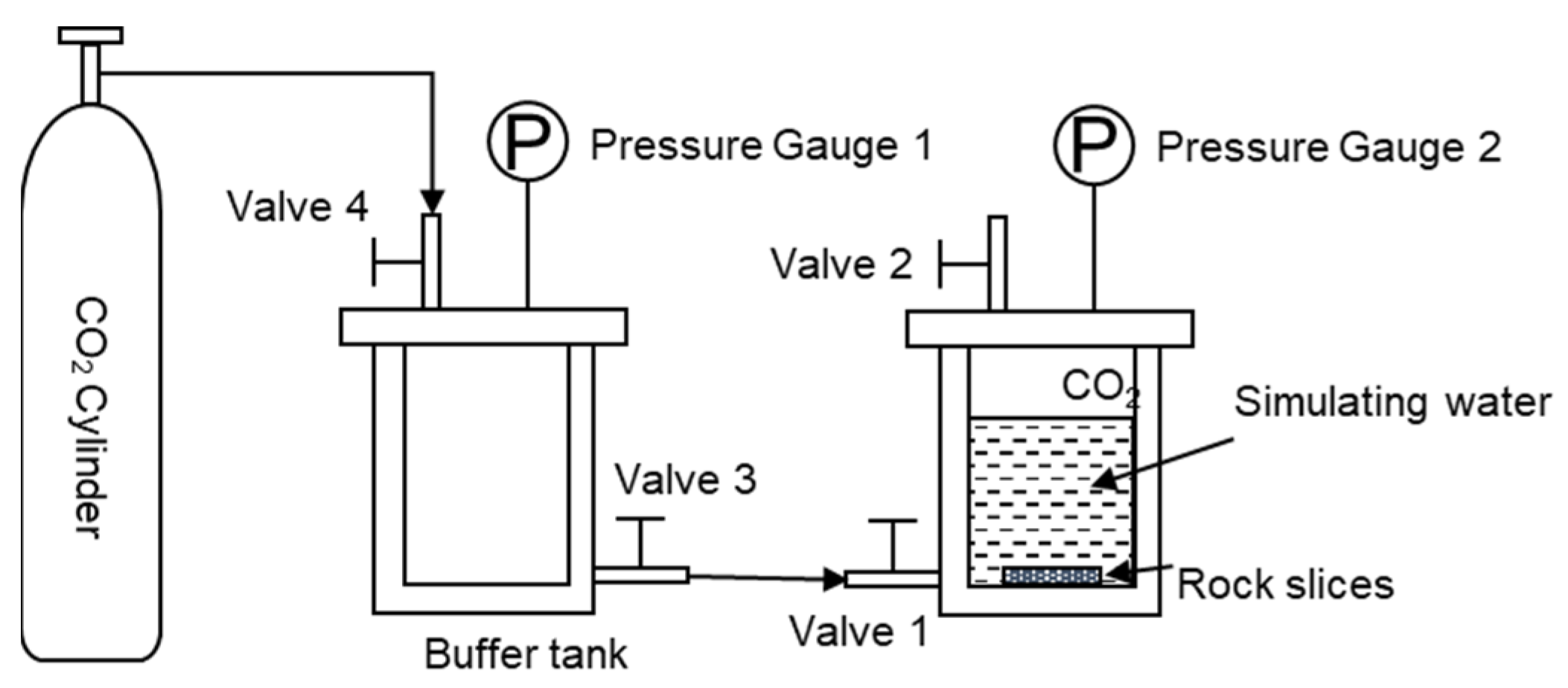
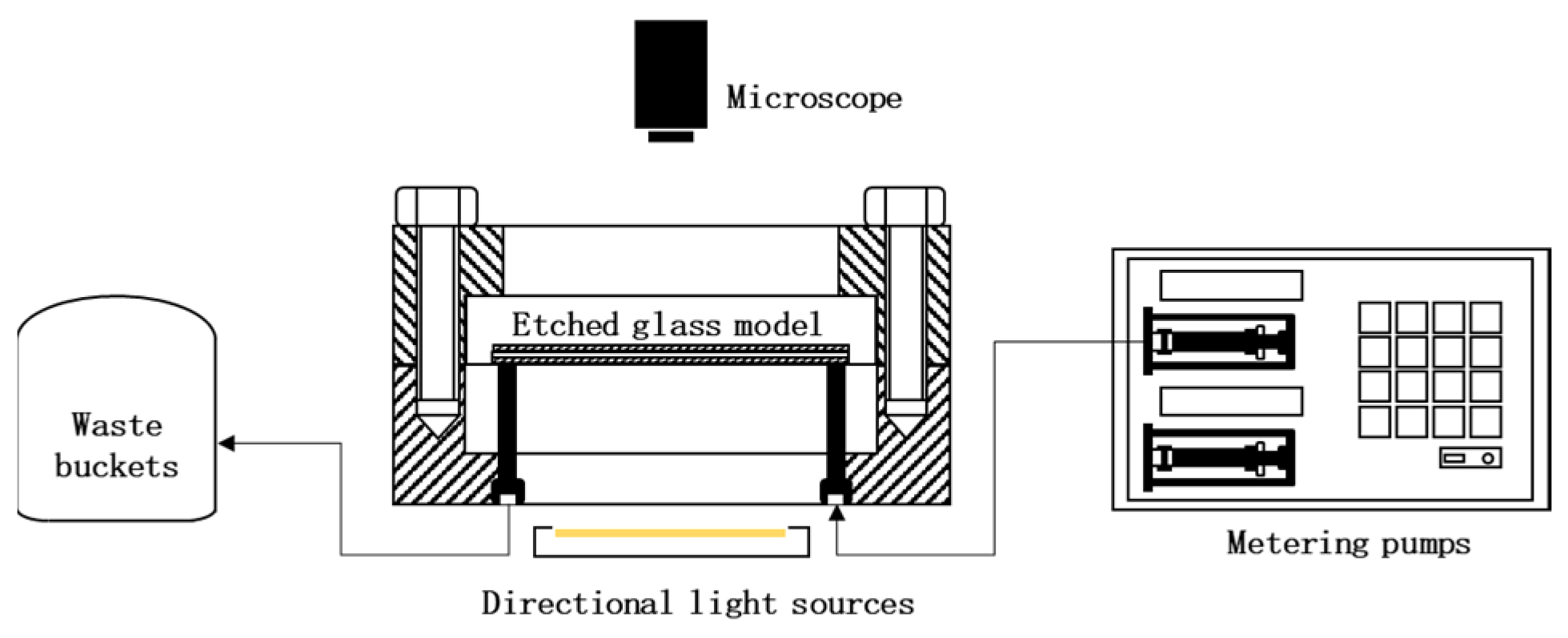
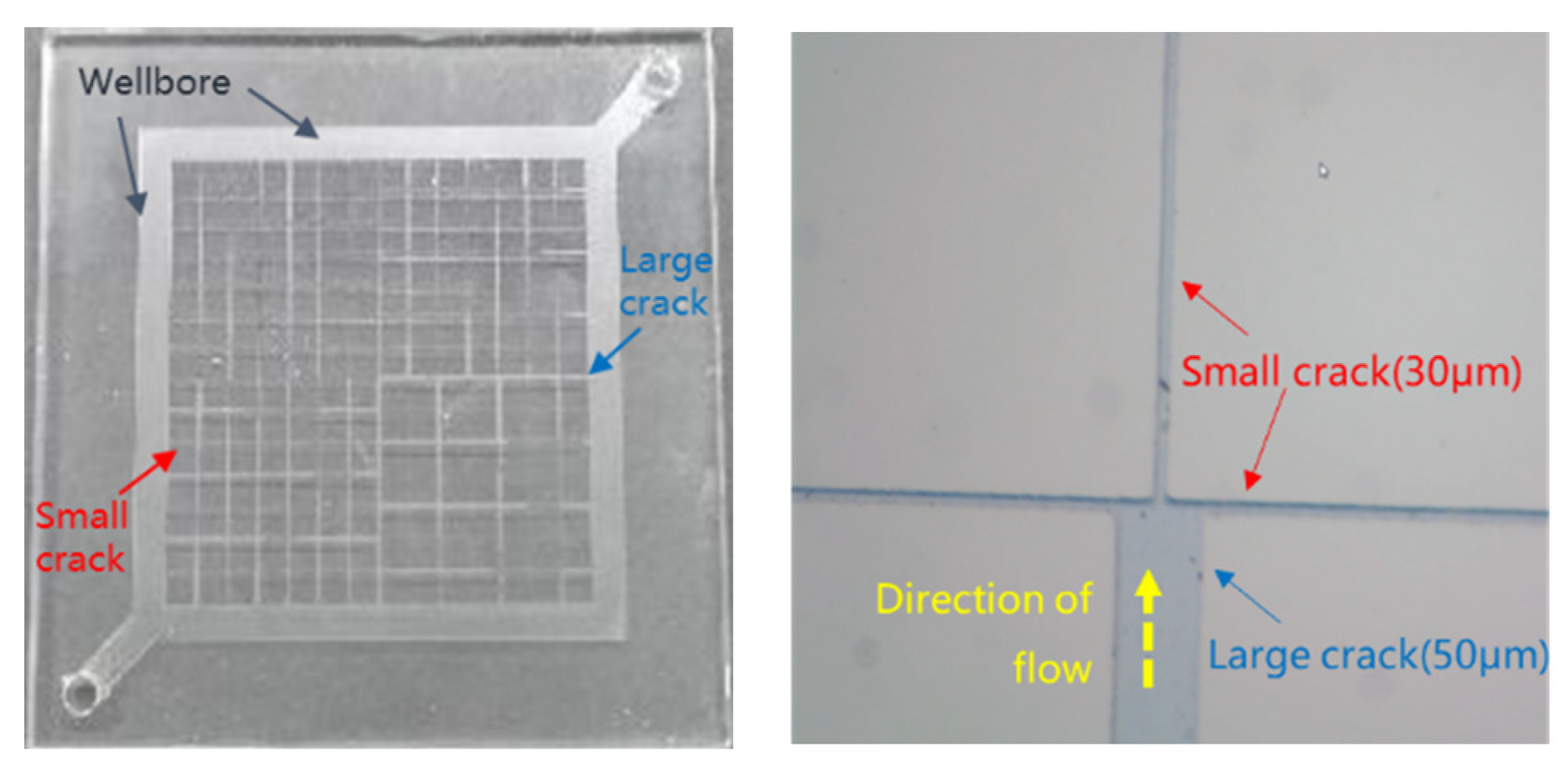
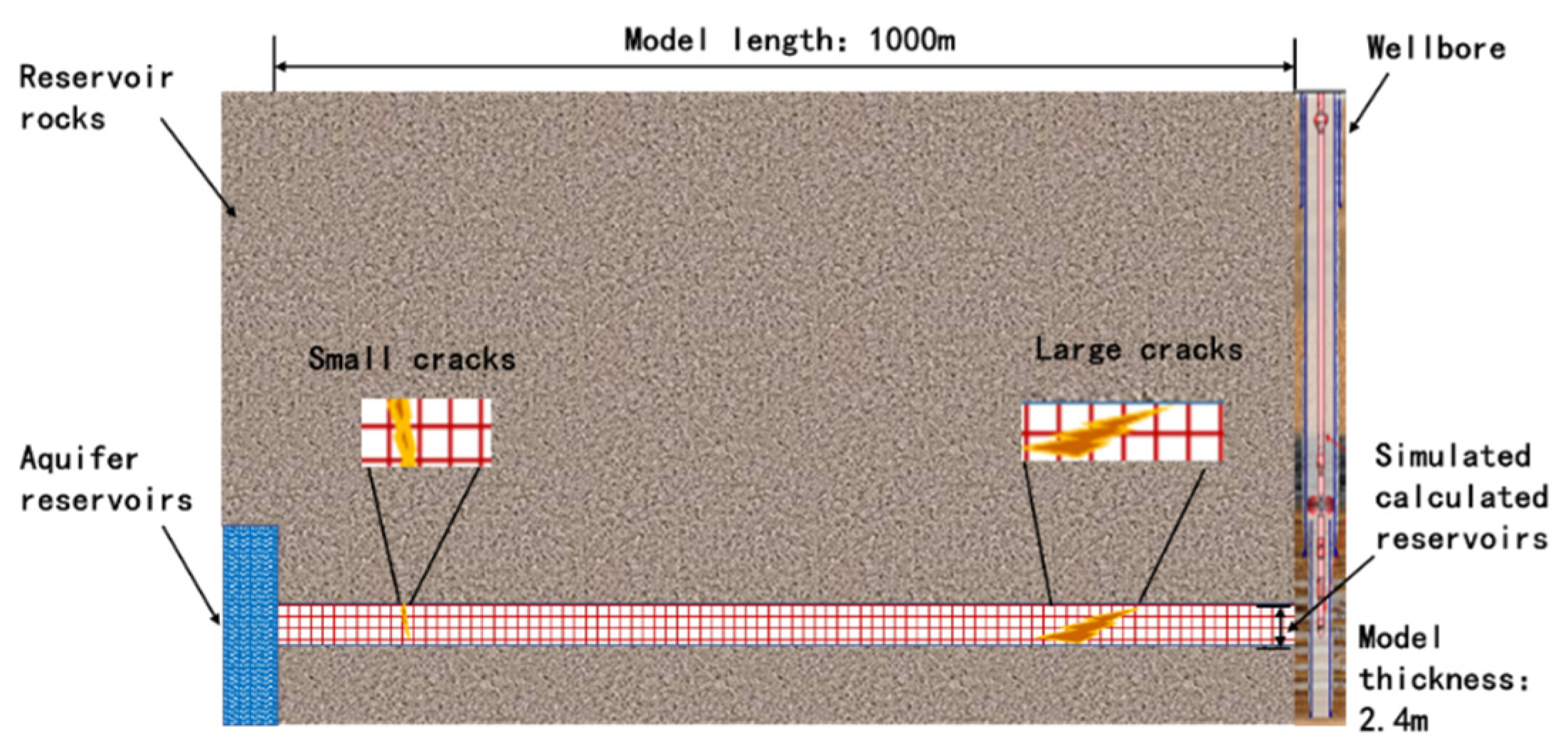
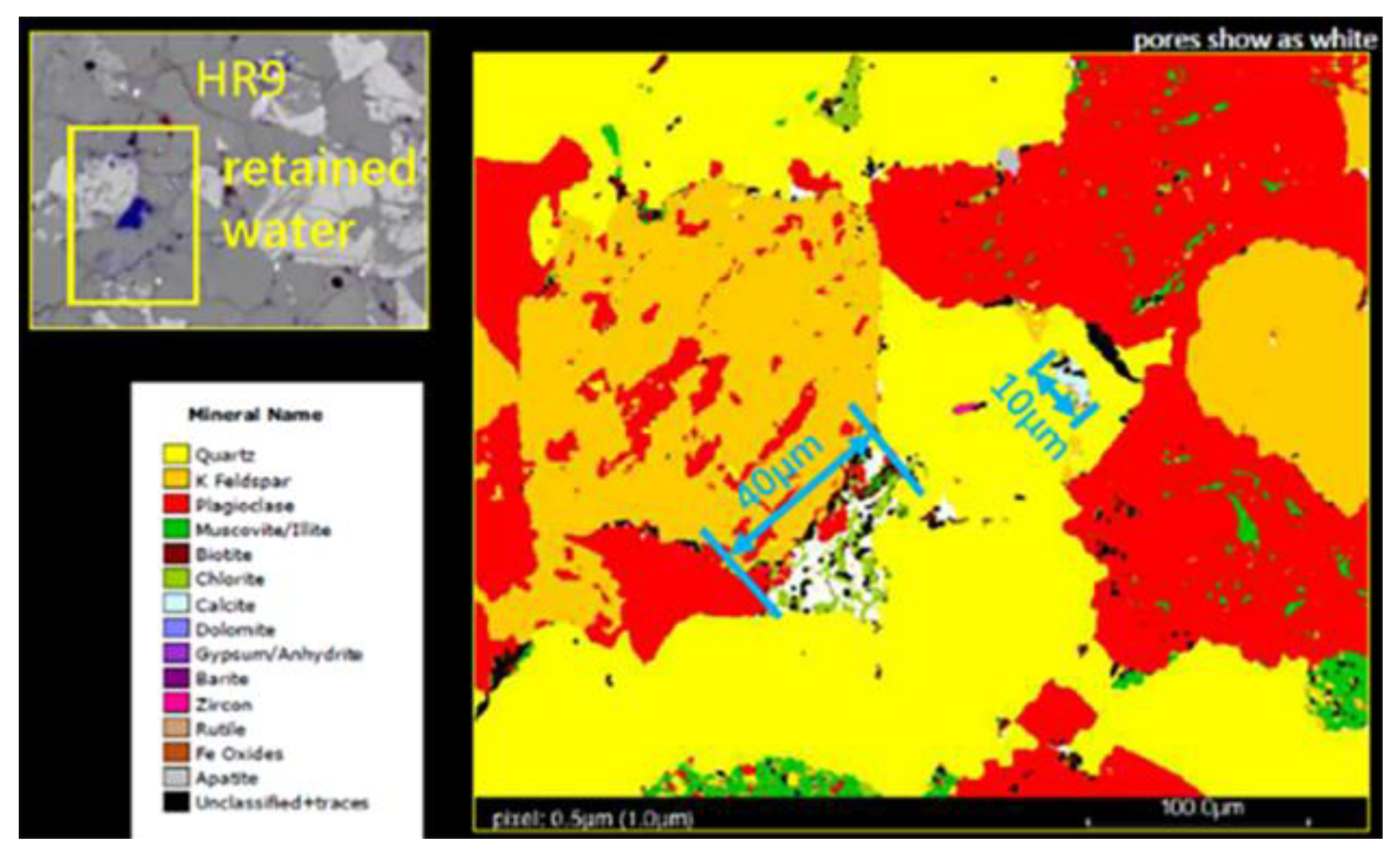






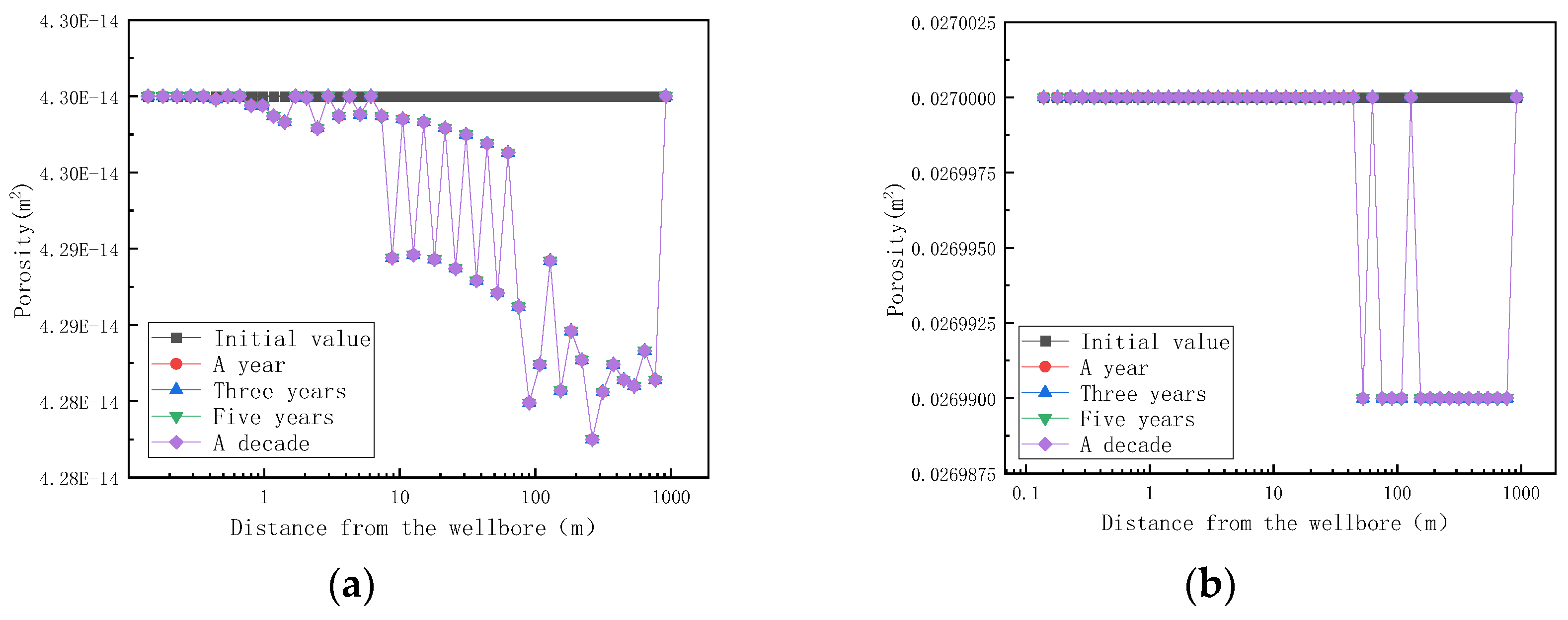

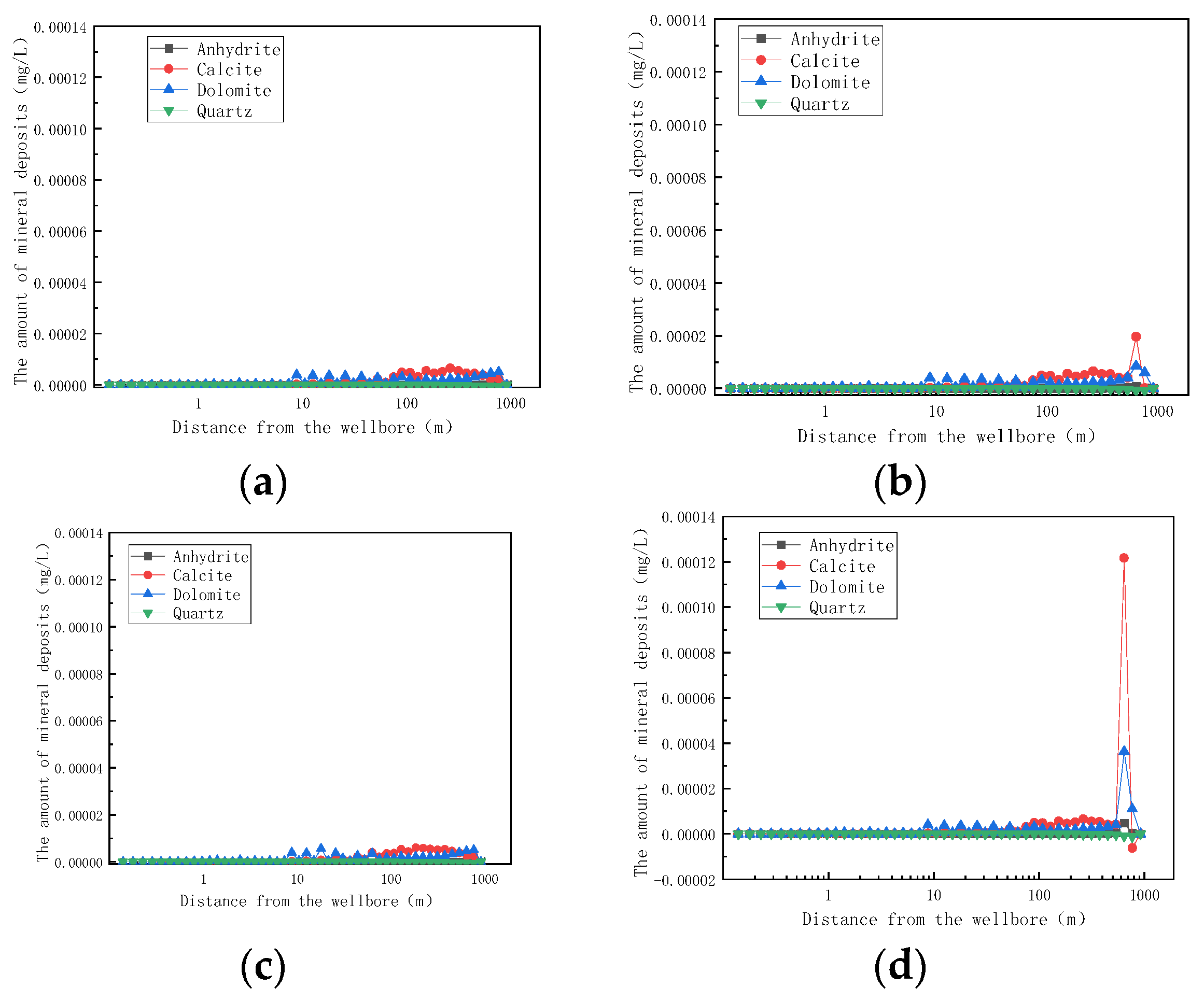
| Rock Density, g/cm3 | Porosity, % | Vertical (z), 10−3 μm2 | Sideways (x) 10−3 μm2 | Sideways (y) 10−3 μm2 |
|---|---|---|---|---|
| 2.53 | 4.67 | 2.56 × 10−2 | 7.09 × 10−3 | 7.09 × 10−3 |
| Ion Type | CO32− | HCO3− | OH− | Cl− | SO42− | Ca2+ | Mg2+ | Ba2+ | Sr2+ | K+ | Na+ |
|---|---|---|---|---|---|---|---|---|---|---|---|
| Ion concentration | 0 | 524 | 0 | 63,600 | 797 | 2750 | 186 | 6.25 | 172 | 3710 | 65,700 |
Disclaimer/Publisher’s Note: The statements, opinions and data contained in all publications are solely those of the individual author(s) and contributor(s) and not of MDPI and/or the editor(s). MDPI and/or the editor(s) disclaim responsibility for any injury to people or property resulting from any ideas, methods, instructions or products referred to in the content. |
© 2024 by the authors. Licensee MDPI, Basel, Switzerland. This article is an open access article distributed under the terms and conditions of the Creative Commons Attribution (CC BY) license (https://creativecommons.org/licenses/by/4.0/).
Share and Cite
Mao, Q.; Lu, L.; Gong, Y.; Zhao, L.; Yang, Z.; Song, H.; Han, R. Research on the Blocking Mechanism of Stagnant Water and the Prediction of Scaling Trend in Fractured Reservoirs in Keshen Gas Field. Processes 2024, 12, 2427. https://doi.org/10.3390/pr12112427
Mao Q, Lu L, Gong Y, Zhao L, Yang Z, Song H, Han R. Research on the Blocking Mechanism of Stagnant Water and the Prediction of Scaling Trend in Fractured Reservoirs in Keshen Gas Field. Processes. 2024; 12(11):2427. https://doi.org/10.3390/pr12112427
Chicago/Turabian StyleMao, Qi, Licheng Lu, Yejing Gong, Libin Zhao, Zihao Yang, Hongzhi Song, and Rui Han. 2024. "Research on the Blocking Mechanism of Stagnant Water and the Prediction of Scaling Trend in Fractured Reservoirs in Keshen Gas Field" Processes 12, no. 11: 2427. https://doi.org/10.3390/pr12112427
APA StyleMao, Q., Lu, L., Gong, Y., Zhao, L., Yang, Z., Song, H., & Han, R. (2024). Research on the Blocking Mechanism of Stagnant Water and the Prediction of Scaling Trend in Fractured Reservoirs in Keshen Gas Field. Processes, 12(11), 2427. https://doi.org/10.3390/pr12112427






